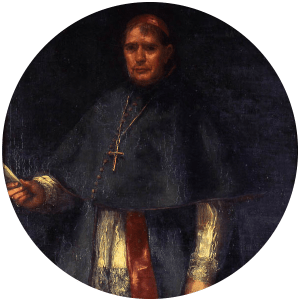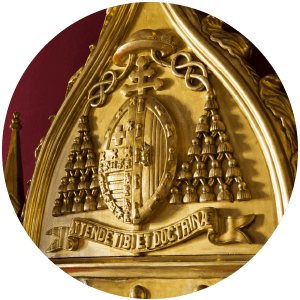The Thorne Hall has represented the main the institutional space of the archbishop’s palace since it was built in the 16th century. Its walls display a Neo-Renaissance decoration chosen by Cardinal Soldevila in 1907. Three balconies allow us to see river Ebro, the same views that general José Palafox had for the Peninsular War (or in Spanish War of Independence), when he disposed his military headquarters in the archbishop palace for 1808 and 1809.
The entire upper perimeter is decorated with a gallery of forty-two court portraits of prelates of Zaragoza, in which archbishops wear vestment and symbolic elements typical of their status and temperament. An exception is marked by Archbishop Manuel Ureña who poses with clergyman costume.
The collection harbours the signature of many important authors, such as Goya, Merklein, Luzán, Montañés, Alda, Gárate, Berdejo and Sister Isabel Guerra.
The Thorne Hall has represented the main the institutional space of the archbishop’s palace since it was built in the 16th century. Its walls display a Neo-Renaissance decoration chosen by Cardinal Soldevila in 1907. Three balconies allow us to see river Ebro, the same views that general José Palafox had for the Peninsular War (or in Spanish War of Independence), when he disposed his military headquarters in the archbishop palace for 1808 and 1809.
The entire upper perimeter is decorated with a gallery of forty-two court portraits of prelates of Zaragoza, in which archbishops wear vestment and symbolic elements typical of their status and temperament. An exception is marked by Archbishop Manuel Ureña who poses with clergyman costume.
The collection harbours the signature of many important authors, such as Goya, Merklein, Luzán, Montañés, Alda, Gárate, Berdejo and Sister Isabel Guerra.

![]()
Francisco de Goya painted Archbishop Joaquin Company’s portrait in 1800. On a dark background, the character emerge showing artist’s great technical mastery and his ability to capture subject’s psychology. The composition is complemented by his coat of arms and some texts, as the paper content which is hold his right hand, where the date of the painting realisation and the artist’s signature are written.

Francisco de Goya painted Archbishop Joaquin Company’s portrait in 1800. On a dark background, the character emerge showing artist’s great technical mastery and his ability to capture subject’s psychology. The composition is complemented by his coat of arms and some texts, as the paper content which is hold his right hand, where the date of the painting realisation and the artist’s signature are written.

![]()
The Neo-Gothic seat of honour that dominates this room was used by Pope John Paul II when he came in his apostolic visit to Zaragoza in 1982. In that moment, he resided in this palace and this is why this room is also known as “Throne of John Paul II”.

The Neo-Gothic seat of honour that dominates this room was used by Pope John Paul II when he came in his apostolic visit to Zaragoza in 1982. In that moment, he resided in this palace and this is why this room is also known as “Throne of John Paul II”.
